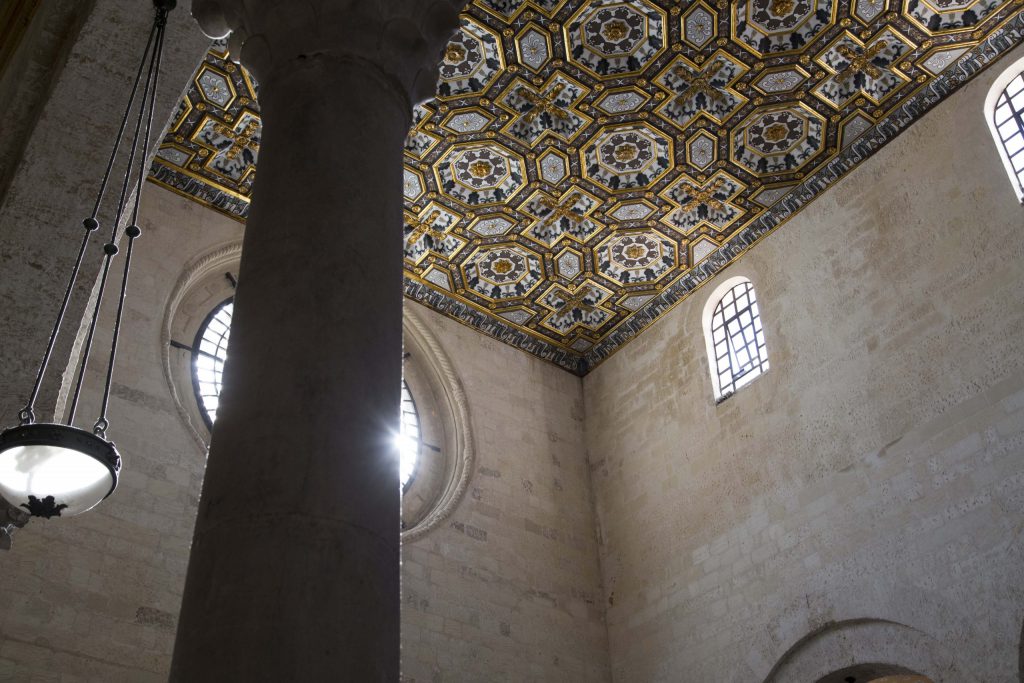The cathedral, built on the remains of a Messapian village, a Roman domus and an early Christian temple, was founded in 1068 by the Norman bishop Guglielmo.
It is a synthesis of different architectural styles including Byzantine, early Christian and Romanesque elements.
In August 1480, the cathedral was the scene of a terrible massacre; the Turks conquered the city after a few days of siege and entered the church, exterminating the clergy and civilians who had taken refuge there. It was transformed into a mosque and all the frescoes dating back to the 13th century were destroyed. In 1481, after the liberation of Otranto by the troops of Alfonso II of Aragon, it was heavily remodeled.

The medieval façade has undergone numerous alterations. Following the devastation inflicted during the Turkish occupation of 1480, the large 16-ray rose window was built with fine circular Gothic tracery converging at the center.
In 1674 the baroque portal was added, composed of two fluted half columns on each side that support the architrave with the coat of arms of Archbishop Gabriel Adarzo de Santander held by two angels. On the sides of the façade there are two single-lancet windows.
Another minor portal is present on the left side of the basilica; it was built between the end of the 15th and the beginning of the 16th century by Nicolò Fernando at the behest of the archbishop Serafino da Squillace who had his own figure sculpted on the structure.
The interior has a three-nave plan with apses, marked by twelve arches in turn supported by fourteen granite columns with different capitals.
In 1693 the archbishop Francesco Maria De Aste had the triumphal arch built and in 1698 he covered the central nave and the presbytery with a wooden coffered ceiling with gilding on a black and white background.
In the presbytery is the main altar with the eighteenth-century silver antependium depicting the Annunciation.
The remaining wall frescoes show Byzantine traces, such as the image of the Madonna and Child in the left nave.
Along the side aisles, covered by a painted panel ceiling created in 1827 by Archbishop Andrea Mansi, six altars are visible dedicated to the Resurrection of Jesus, to Saint Dominic of Guzman, to the Madonna Assunta (on the right), to Pentecost, to the Visitation of the Blessed Virgin Mary and to Saint Anthony of Padua (on the left).
In the left nave there is the baroque baptistery commissioned by Archbishop Michele Orsi around the middle of the 18th century. In the same nave there is the sepulchral monument of Francesco Maria de Aste, who died in 1719, and the mausoleum of Metropolitan Gaetano Cosso, who died in 1655.
The right nave ends in the Martyrs' Chapel, built by order of Ferdinand I of Naples and rebuilt at public expense in 1711. It houses the mortal remains of the holy martyrs of Otranto, the eight hundred inhabitants of Otranto massacred and beheaded by the Turks on the Colle della Minerva on 14 August 1480.
The relics of the martyrs are placed in seven large cupboards and behind the marble altar is kept the “martyrdom stone” on which, according to tradition, the beheading took place.
Along the naves, the presbytery and the apse are developed in a majestic medieval mosaic. It was commissioned by the first Latin archbishop of the city, Gionata, and was executed between 1163 and 1165 by a group of artists led by Pantaleone, a Basilian monk from the monastery of San Nicola di Casole.
The iconographic program of the mosaic develops through scenes from the Old Testament, from chivalric cycles, and from medieval bestiaries.
The images, arranged along the development of the Tree of Life, retrace the human experience from original sin to salvation.
The crypt dates back to the 11th century and is a miniature of the famous Cistern of Theodosius or the Mosque of Cordoba.
It has three semicircular apses and is characterised by forty-eight bays interspersed with over seventy columns, semi-columns and pillars.
The peculiarity lies in the diversity of the supporting elements, coming from ancient and early medieval buildings, and from the multiple figurative repertoire.
Of great value are the surviving frescoes which span a chronological period from the Middle Ages to the sixteenth century.
The bell tower was built in the immediate vicinity of the cathedral in the 12th century, under Norman rule. The monumental structure has a square plan, with a robust elevation softened by four round-arched windows.
The arches, frames, strips and brackets that decorate the exterior recall the same motifs, dear to military architecture, visible on the walls and defence towers of the city.
The materials used in the construction are carparo and compact white limestone, typical materials of the Salento area.
The current tower was most likely the base of a taller structure, with sighting and signaling functions. The elevated position, dominating the city and the body of water in front, allowed the alarm to be raised in case of danger. This functional purpose, common in the past, justifies the position detached from the sacred building.
In the right arm of the transept, on the floor, there is an ancient pipe organ. The instrument was built in the first half of the 18th century by the Gallipoli organ-building brothers Simone and Pietro Kircher.
The instrument was made during the episcopate of Michele Orsi (1722-1752) and placed above a choir on the back wall of the right transept. In 1947, the choir was demolished and the organ was set aside in the transept; restoration work began only in 1986 and was completed in 1995.

 Amore DI Puglia Pillow
Amore DI Puglia Pillow




















Leave a comment